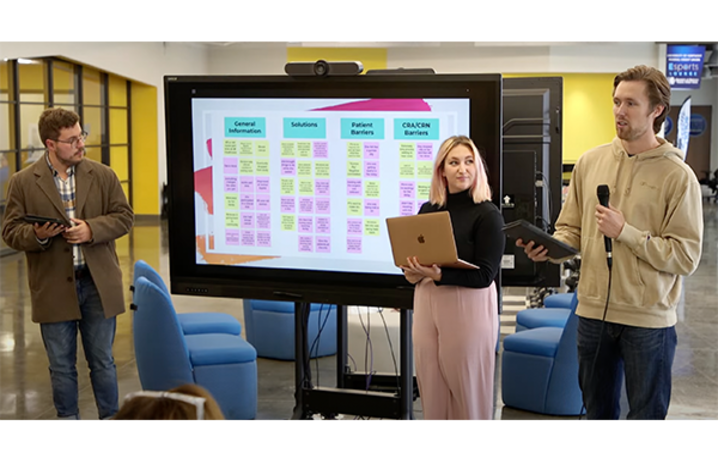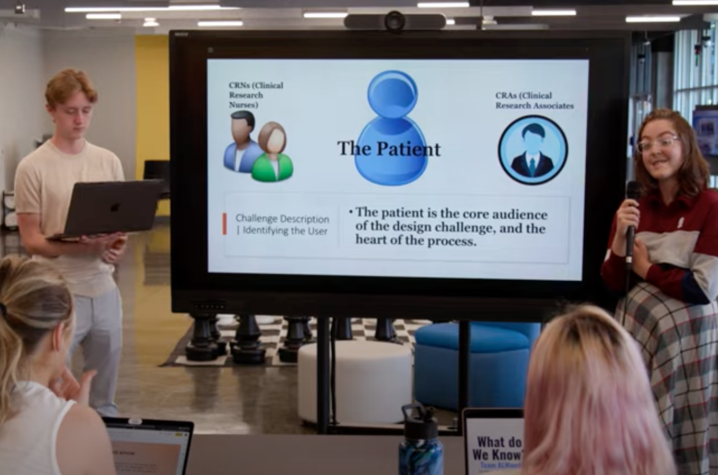Design Thinking: How UK prepares students for real-world problem solving
Video produced by UK Marketing and Brand Strategy. To view captions for this video, push play and click on the CC icon in the bottom right hand corner of the screen. If using a mobile device, click on the "thought bubble" in the same area.
LEXINGTON, Ky. (March 24, 2023) — “The problem is not the problem.”
This phrase leads a University of Kentucky “design thinking” course, where students apply the concept to help understand a problem that affects their local community and create meaningful solutions to the problem.
Created and piloted by faculty from the UK College of Education, the UK College of Agriculture, Food, and Environment, UK Libraries and the UK Markey Cancer Center, the course was titled “Design Thinking in Education.”
“The challenge of the semester was working with Markey Cancer Center trying to improve patient diagnostic experience for cancer patients,” said Ryan Hargrove, Ph.D., associate professor in the College of Agriculture, Food and Environment. “That also involved working closely with the hospital and trying to improve their accrual rates (for clinical trials).”
Receiving a diagnosis of cancer can be an overwhelming experience for patients, who then have to navigate the financial, social, physical and emotional issues that follow this life-changing news. Taught by Hargrove and John Nash, Ph.D., an associate professor in the College of Education, the class worked closely with Markey’s Patient Advisory Group, a committee of Markey patients who give feedback on all aspects of care at the cancer center.
Through this course, the students learned to work as a team, think critically and use their creativity to address this highly emotional and difficult challenge for cancer patients.
“We go through several phases of design thinking style in the class,” said Nash. “We start with discovery, then we define the problem, followed by brainstorming solutions and finally prototyping and feedback.”
“One really important part of the process above is that when they were discovering what the patients’ needs are, they actually took a tour of Markey,” Hargrove said. “I think at some point in the process they felt the gravity of the problem, specifically during the patient walk. They understood this is not me anymore — this is impacting many people on a daily basis at Markey. And it brought a realness and a rawness to the problem.”
The class was unique because it not only dissected a real-world problem, but a problem that existed in the students’ very own community.
“Our Patient Advisory Group’s (PAG) initiative to increase the number of patients who participate in Markey’s clinical studies proved a perfect fit for a Design Thinking class project,” said Terry Keys, Markey’s patient advocacy manager. “As the team’s ‘customer,’ I attended the classes and was impressed by the insights and creativity the students brought to this real-world issue, particularly after the students got a patient’s-eye-view of the Markey campus,” he said.
The class ended in a day of presentations, where the students shared their proposed solutions and recommendations to community partners, including Markey’s Patient Advisory Group.
“The presentations were actually handed over to Markey and the patient advisory group who take these recommendations and can then use them to form their own policy recommendations,” Nash said.
The students’ work has already made a difference — Keys notes the group has already begun developing ways to make the proposed recommendations a reality.
“Now that the student presentations are over, the work of our PAG begins as we take the students’ ideas and try to put them into practice,” Keys said. ”We already have a small pilot project in the works and are planning to expand the pilot into a research study of its own. That wouldn’t have been possible without the input of the students.”
When reflecting on the semester, students had this to say.
“I feel like this is the first time in my education I’ve actually had the chance to take something and turn it into more than a hypothetical,” said Matt McBee, a landscape architecture student.
“Design thinking for me has been really eye-opening, insightful and really good for me to go through,” said Tori Alleman, a secondary and English education student. “I would love to apply design thinking principles in other classrooms.”
The professors also felt the impact of the work.
“The semester was a rollercoaster of emotions, in all the good ways,” Hargrove said. “I think it shows the value of having a class like this and working on a problem like this.”
****
Design Thinking in Education is just the beginning of UK’s new campus initiative that builds upon the existing efforts to put students first.
The new initiative, Transdisciplinary Educational Approaches to Advanced Kentucky (TEK), will provide even more opportunities for the Wildcat family to collaborate, helping UK students learn important employability skills.
TEK serves as the institution’s Quality Enhancement Plan, or QEP, which is a key part of UK’s reaccreditation for the Southern Association of Colleges and Schools Commission on Colleges (SACSCOC), the body that accredits UK as an institution of higher learning.
To learn more about TEK, watch this video or visit http://go.uky.edu/TEK.
Learn more about Design Thinking in Education here.


As the state’s flagship, land-grant institution, the University of Kentucky exists to advance the Commonwealth. We do that by preparing the next generation of leaders — placing students at the heart of everything we do — and transforming the lives of Kentuckians through education, research and creative work, service and health care. We pride ourselves on being a catalyst for breakthroughs and a force for healing, a place where ingenuity unfolds. It's all made possible by our people — visionaries, disruptors and pioneers — who make up 200 academic programs, a $476.5 million research and development enterprise and a world-class medical center, all on one campus.




